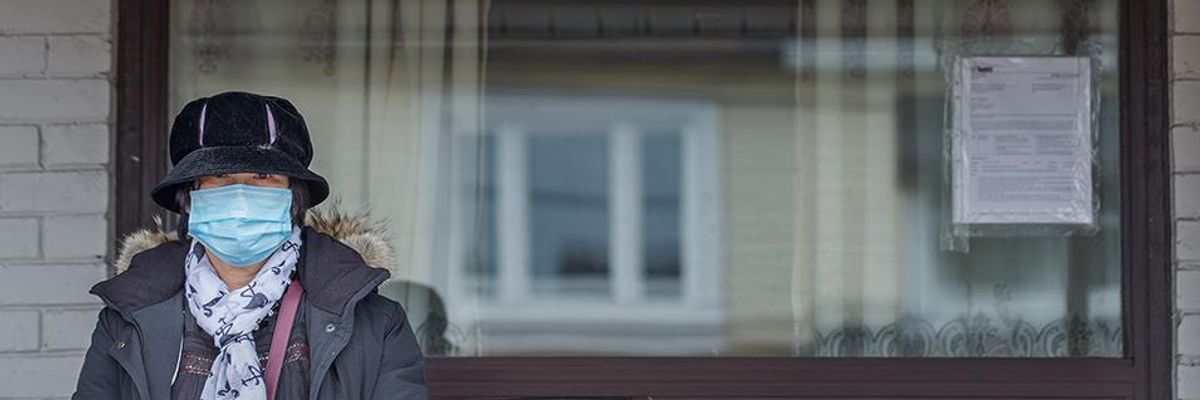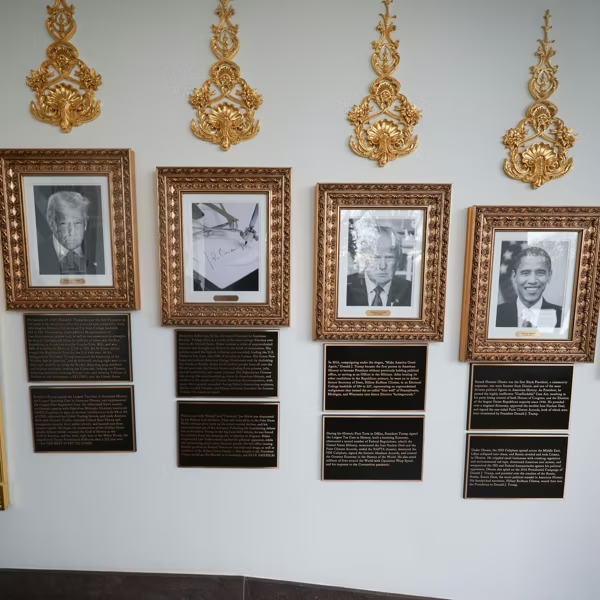
Failures of privatized LTCs cries out for more public ownership and control over long-term care homes. Lily Wong, a kitchen worker in a LTC. (Rick Madonik/Toronto Star via Getty Images)
Bare-Knuckle Capitalism has No Place in Nursing Homes
Privatized profit-making in homes caring for the elderly
When it became clear last fall that the province's long-term care (LTC) homes were about to be engulfed by the second wave of the pandemic, the Ford government swung into action.
Wasting no time, it promptly introduced legislation -- legislation that gave the corporate owners of long-term care homes extra protection from lawsuits that were accumulating against them.
Tragically, the province has shown no such speed or dedication to the task of providing extra protection -- or much protection at all -- to the elderly people who live in these homes and who, unlike the corporate owners, really are helpless to defend themselves.
It's striking that Premier Doug Ford has given priority to the interests of these corporate owners even as the coronavirus has swept through LTC homes, turning them into gruesome death traps and claiming the lives of almost 3,000 residents.
Investigations, including those done by Toronto Star reporters, have found that the coronavirus death rate has been significantly higher in for-profit homes than in not-for-profit homes.
Dramatic as this finding is, it may only hint at the extent of the problem resulting from allowing the for-profit sector to operate in the Long-Term care industry.
Indeed, the greatest danger may be posed by the emergence in the industry of "financialized" enterprises -- firms that operate according to a more bare-knuckle type of capitalism, associated with the financial industry, that focuses relentlessly on cost-cutting to drive ever-higher profit margins.
These financialized firms -- which include private equity funds and real estate investment trusts (REIT) -- have become a major presence in the seniors housing industry. They operate large chains and now control just over 30 percent of government-funded LTC homes in Ontario.
Perhaps not surprisingly, LTC homes controlled by these financialized firms have experienced even higher coronavirus death rates than LTC homes controlled by other for-profit operators, according to Martine August, assistant professor at the University of Waterloo's School of Planning.
So if there are concerns about permitting profit-making in homes caring for the elderly -- and there should be -- these financialized firms should be particularly setting off alarms.
The financialized firms are "like private ownership on steroids," August says.
One concern is the impact on labor, the biggest cost driver in LTC homes. Unions representing LTC workers charge that for-profit homes generally pay very low wages and offer mostly part-time and casual work -- reducing the chance of meaningful relationships developing between staff and residents.
As for financialized LTCs specifically, there's little Canadian research but international studies show they tend to have fewer staff hours and lower-quality care, allowing them to increase shareholder dividends and raise executive pay, says August.
All this cries out for more public ownership and control over long-term care homes.
But, in recent decades, Ontario has gone in the opposite direction, encouraging private ownership in the industry. Roughly 57 percent of the province's LTCs are now privately owned, with two U.S.-based REITs, Ventas and Welltower, among the biggest players in the industry.
The move toward privatization got started under then-Conservative premier Mike Harris, whose government made long-term care more attractive to private business by removing minimum staffing levels in the homes, making them ripe for profit-making.
Harris also paved the way for privatization with his deep cuts to Ontario's social spending. This meant significant reductions in hospital beds, forcing seniors requiring care into LTC homes, which received smaller per-patient government subsidies.
From his vantage point as premier, with projections showing a coming explosion in the demand for seniors housing, Harris had little trouble spotting the lucrative potential for financialized firms in the industry. After retiring as premier in 2002, he quickly became chairman of a newly formed REIT called Chartwell Retirement Residences, which operates both publicly funded LTC homes and privately paid retirement homes.
Over the past decade, Chartwell has distributed $798 million to shareholders and paid its executives $47.3 million, including an annual salary of $229,500 for the former premier's part-time chairmanship, which he still holds.
Mike Harris' involvement in the dubious rise of privatization -- and financialization -- in the long-term care industry makes it all the more outrageous that the Ford government recently awarded him the Order of Ontario, even as the pandemic continues its relentless slaughter of helpless LTC residents.
An Urgent Message From Our Co-Founder
Dear Common Dreams reader, The U.S. is on a fast track to authoritarianism like nothing I've ever seen. Meanwhile, corporate news outlets are utterly capitulating to Trump, twisting their coverage to avoid drawing his ire while lining up to stuff cash in his pockets. That's why I believe that Common Dreams is doing the best and most consequential reporting that we've ever done. Our small but mighty team is a progressive reporting powerhouse, covering the news every day that the corporate media never will. Our mission has always been simple: To inform. To inspire. And to ignite change for the common good. Now here's the key piece that I want all our readers to understand: None of this would be possible without your financial support. That's not just some fundraising cliche. It's the absolute and literal truth. We don't accept corporate advertising and never will. We don't have a paywall because we don't think people should be blocked from critical news based on their ability to pay. Everything we do is funded by the donations of readers like you. Will you donate now to help power the nonprofit, independent reporting of Common Dreams? Thank you for being a vital member of our community. Together, we can keep independent journalism alive when it’s needed most. - Craig Brown, Co-founder |
When it became clear last fall that the province's long-term care (LTC) homes were about to be engulfed by the second wave of the pandemic, the Ford government swung into action.
Wasting no time, it promptly introduced legislation -- legislation that gave the corporate owners of long-term care homes extra protection from lawsuits that were accumulating against them.
Tragically, the province has shown no such speed or dedication to the task of providing extra protection -- or much protection at all -- to the elderly people who live in these homes and who, unlike the corporate owners, really are helpless to defend themselves.
It's striking that Premier Doug Ford has given priority to the interests of these corporate owners even as the coronavirus has swept through LTC homes, turning them into gruesome death traps and claiming the lives of almost 3,000 residents.
Investigations, including those done by Toronto Star reporters, have found that the coronavirus death rate has been significantly higher in for-profit homes than in not-for-profit homes.
Dramatic as this finding is, it may only hint at the extent of the problem resulting from allowing the for-profit sector to operate in the Long-Term care industry.
Indeed, the greatest danger may be posed by the emergence in the industry of "financialized" enterprises -- firms that operate according to a more bare-knuckle type of capitalism, associated with the financial industry, that focuses relentlessly on cost-cutting to drive ever-higher profit margins.
These financialized firms -- which include private equity funds and real estate investment trusts (REIT) -- have become a major presence in the seniors housing industry. They operate large chains and now control just over 30 percent of government-funded LTC homes in Ontario.
Perhaps not surprisingly, LTC homes controlled by these financialized firms have experienced even higher coronavirus death rates than LTC homes controlled by other for-profit operators, according to Martine August, assistant professor at the University of Waterloo's School of Planning.
So if there are concerns about permitting profit-making in homes caring for the elderly -- and there should be -- these financialized firms should be particularly setting off alarms.
The financialized firms are "like private ownership on steroids," August says.
One concern is the impact on labor, the biggest cost driver in LTC homes. Unions representing LTC workers charge that for-profit homes generally pay very low wages and offer mostly part-time and casual work -- reducing the chance of meaningful relationships developing between staff and residents.
As for financialized LTCs specifically, there's little Canadian research but international studies show they tend to have fewer staff hours and lower-quality care, allowing them to increase shareholder dividends and raise executive pay, says August.
All this cries out for more public ownership and control over long-term care homes.
But, in recent decades, Ontario has gone in the opposite direction, encouraging private ownership in the industry. Roughly 57 percent of the province's LTCs are now privately owned, with two U.S.-based REITs, Ventas and Welltower, among the biggest players in the industry.
The move toward privatization got started under then-Conservative premier Mike Harris, whose government made long-term care more attractive to private business by removing minimum staffing levels in the homes, making them ripe for profit-making.
Harris also paved the way for privatization with his deep cuts to Ontario's social spending. This meant significant reductions in hospital beds, forcing seniors requiring care into LTC homes, which received smaller per-patient government subsidies.
From his vantage point as premier, with projections showing a coming explosion in the demand for seniors housing, Harris had little trouble spotting the lucrative potential for financialized firms in the industry. After retiring as premier in 2002, he quickly became chairman of a newly formed REIT called Chartwell Retirement Residences, which operates both publicly funded LTC homes and privately paid retirement homes.
Over the past decade, Chartwell has distributed $798 million to shareholders and paid its executives $47.3 million, including an annual salary of $229,500 for the former premier's part-time chairmanship, which he still holds.
Mike Harris' involvement in the dubious rise of privatization -- and financialization -- in the long-term care industry makes it all the more outrageous that the Ford government recently awarded him the Order of Ontario, even as the pandemic continues its relentless slaughter of helpless LTC residents.
When it became clear last fall that the province's long-term care (LTC) homes were about to be engulfed by the second wave of the pandemic, the Ford government swung into action.
Wasting no time, it promptly introduced legislation -- legislation that gave the corporate owners of long-term care homes extra protection from lawsuits that were accumulating against them.
Tragically, the province has shown no such speed or dedication to the task of providing extra protection -- or much protection at all -- to the elderly people who live in these homes and who, unlike the corporate owners, really are helpless to defend themselves.
It's striking that Premier Doug Ford has given priority to the interests of these corporate owners even as the coronavirus has swept through LTC homes, turning them into gruesome death traps and claiming the lives of almost 3,000 residents.
Investigations, including those done by Toronto Star reporters, have found that the coronavirus death rate has been significantly higher in for-profit homes than in not-for-profit homes.
Dramatic as this finding is, it may only hint at the extent of the problem resulting from allowing the for-profit sector to operate in the Long-Term care industry.
Indeed, the greatest danger may be posed by the emergence in the industry of "financialized" enterprises -- firms that operate according to a more bare-knuckle type of capitalism, associated with the financial industry, that focuses relentlessly on cost-cutting to drive ever-higher profit margins.
These financialized firms -- which include private equity funds and real estate investment trusts (REIT) -- have become a major presence in the seniors housing industry. They operate large chains and now control just over 30 percent of government-funded LTC homes in Ontario.
Perhaps not surprisingly, LTC homes controlled by these financialized firms have experienced even higher coronavirus death rates than LTC homes controlled by other for-profit operators, according to Martine August, assistant professor at the University of Waterloo's School of Planning.
So if there are concerns about permitting profit-making in homes caring for the elderly -- and there should be -- these financialized firms should be particularly setting off alarms.
The financialized firms are "like private ownership on steroids," August says.
One concern is the impact on labor, the biggest cost driver in LTC homes. Unions representing LTC workers charge that for-profit homes generally pay very low wages and offer mostly part-time and casual work -- reducing the chance of meaningful relationships developing between staff and residents.
As for financialized LTCs specifically, there's little Canadian research but international studies show they tend to have fewer staff hours and lower-quality care, allowing them to increase shareholder dividends and raise executive pay, says August.
All this cries out for more public ownership and control over long-term care homes.
But, in recent decades, Ontario has gone in the opposite direction, encouraging private ownership in the industry. Roughly 57 percent of the province's LTCs are now privately owned, with two U.S.-based REITs, Ventas and Welltower, among the biggest players in the industry.
The move toward privatization got started under then-Conservative premier Mike Harris, whose government made long-term care more attractive to private business by removing minimum staffing levels in the homes, making them ripe for profit-making.
Harris also paved the way for privatization with his deep cuts to Ontario's social spending. This meant significant reductions in hospital beds, forcing seniors requiring care into LTC homes, which received smaller per-patient government subsidies.
From his vantage point as premier, with projections showing a coming explosion in the demand for seniors housing, Harris had little trouble spotting the lucrative potential for financialized firms in the industry. After retiring as premier in 2002, he quickly became chairman of a newly formed REIT called Chartwell Retirement Residences, which operates both publicly funded LTC homes and privately paid retirement homes.
Over the past decade, Chartwell has distributed $798 million to shareholders and paid its executives $47.3 million, including an annual salary of $229,500 for the former premier's part-time chairmanship, which he still holds.
Mike Harris' involvement in the dubious rise of privatization -- and financialization -- in the long-term care industry makes it all the more outrageous that the Ford government recently awarded him the Order of Ontario, even as the pandemic continues its relentless slaughter of helpless LTC residents.

